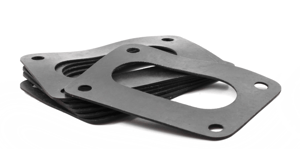Let’s say you’re looking for highly specialized products and materials. Sure, you could try a pre-made part, but what about the gasket you really need?
Over the past three decades, Strouse has helped bring hundreds of unique gasket designs to market by finding accurate and successful ways to build unique production processes.
Today, we will review the uses of conductive gaskets, their materials, and where to find them.
What is a Conductive Gasket?
Conductive gaskets seal two surfaces while acting as a conductive medium for electricity or shielding against signal interference.
APPLICATIONS
Examples of conductive gasket applications include:
- Electromagnetic interference (EMI) gasketing & Radio Frequency (RF) shielding
- Electrostatic discharge (ESD) protection
- Applications in EV batteries
- Mobile handheld device components
Conductive Gasket Materials
Your ideal conductive gasket material may vary depending on the level of conductivity you seek and the substrate you’re adhering to.
1. SILICONE
Conductive gaskets are commonly made from high-quality silicone with conductive particles. Materials like carbon, nickel, and silver help conduct electricity.
Regular silicone is an insulator, but these embedded silicones are conductive and hold different mechanical properties. While the normal silicone gaskets will be softer, lighter, and more extensible, particle-filled silicone will be more rigid and dense with less elasticity.
From a processing standpoint, filled silicone will be much more abrasive for die cutting and will eat through tooling more quickly. However, it will also be more stable and easier to cut to a desired size/tolerance.
2. FLUOROSILICONE
Fluorosilicone is similar to silicone but contains fluoroelastomers, which allow it to withstand heat, solvents, and chemicals. You can also use fluorosilicone for conductive applications.
Conductive fluorosilicone gaskets can withstand extreme temperatures and resist oil or petroleum-based chemicals. Unfortunately, they’re more expensive and lack the flexibility of conductive silicone.
3. EPDM RUBBER
EPDM (Ethylene Propylene Diene Monomer) rubber is often compounded with carbon black filler, making it electrically conductive while dissipating electrostatic discharge.
EPDM gaskets are highly resistant to chemicals, but unfortunately, they are also vulnerable to hydrocarbons (like gasoline) and melting.
4. SILVER ALUMINUM
Silver aluminum conductive gaskets consist of a base material such as silicone rubber or fluorosilicone mixed with silver-plated aluminum particles.
These silver-plated aluminum particles facilitate conductivity between components in electronic assemblies and create a conductive path that can help block electromagnetic interference.
Silver aluminum gaskets may require a higher sealing force because they’re metal gaskets (manufactured with elemental metals or alloys).
5. ORIENTED WIRE
Oriented wire gaskets are cut from flat sheet metal, specifically a combination of silicone rubber and monel wires (a nickel-copper alloy).
Oriented wire gaskets can protect against the elements and shield EMI/RFI at lower frequencies. The wires running through the gasket's length allow for conductivity.
Gasketing Considerations
So, let’s assume that conductive gaskets appeal to your project needs: what’s the next step in the process?
Think of this as a checklist of sorts. If you can confidently answer the following, you’re likely prepared to bring your design to a converter for manufacturing.
- What is the specific intended function of the gasket in the particular application?
-
-
- What is the gasket keeping out/in?
- Will this be a permanent 1-time use or a periodically replaced consumable?
- Is a mechanical bond via fasteners or adhesive required for structural assembled strength?
- How do you plan to build your assembly?
-
- How will this function affect your gasket needs?
-
-
- Conductivity requirements?
- Functional temperature requirements?
- Chemistry requirements?
- Is it a pressurized application (pressure range)?
- What’s the environmental condition?
-
- Design/features size/shape?
-
-
- Thickness/gap fill requirement?
- Critical tolerance consideration?
- Specific durometer requirement?
-
Although it may seem tedious, these questions are crucial to understanding the viability of your project.
How Do I Find the Right Conductive Gasket?
Finding a suitable gasket for your project depends on your material, design, and the design’s final purpose.
Your conductive gasket must be manufactured in a specific shape with unique material and conductivity requirements. So, where can you turn for custom gaskets?
A flexible material converter will assist you by providing samples and information about the production process.
To learn more about our production process, you can contact us or visit our capabilities page for more details.







